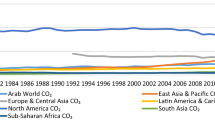Abstract
We construct a Seemingly Unrelated Regression (SUR) model to investigate the link between local environmental pollution (sulfur dioxide-SO2 and nitrogen oxides-NOx emissions) and economic growth on a panel data set framework for the US over the period 1990–2012. The presence of different polynomials of GDP for each equation of SO2 and NOx respectively allows us to utilize a SUR model to estimate jointly the two equations in order to examine the total effect of environmental degradation. While we find evidence of a quartic relationship between SO2 emissions and economic development in a single equation framework this outcome does not seem to hold when we utilize a SUR model controlling for cross section dependence.
Similar content being viewed by others
Notes
EKC hypothesis implies a non linear relationship of an inverted ‘U’ type between environmental degradation and economic growth.
It is worth mentioning that a polynomial regression raises some challenging technical issues that must be addressed (Wagner and Hong 2016).
The CD tests were carried out in STATA using the “xtcd” and “xtcsd” routines, while we use two Breusch–Pagan LM tests. The first test allows for groupwise heteroskedasticity by using the command “xttest2” and the second is a Modified Wald test for groupwise heteroskedasticity in fixed effect regression model by using the command “xttest3”.
The tests were carried out in STATA using the “xtwest” routine. It should be noted that the results are sensitive to the selection of the lag structure of the model. Persyn and Westerlund (2008) point out that this sensitivity might occur in small datasets.
The degree of the polynomial for each equation has been determined by the maximum number of statistically significant powers. For example in the case of NOX third and higher degree polynomial specifications have the extra powers of GDP to be not statistically significant.
However, the Wooldridge tests for first order autocorrelation denote that the errors display serial dependence.
If b1 > 0, b2 < 0 and b3 > 0, then we come up with an N-shaped relationship or cubic polynomial (Kijima et al. 2010).
References
Breitung, J., Das, S.: Panel unit root tests under cross-sectional dependence. Stat. Neerl. 59, 414–433 (2005)
Breusch, T.S., Pagan, A.R.: The Lagrange multiplier test and its applications to model specification in econometrics. Rev. Econ. Stud. 47(1), 239–253 (1980)
Dean, J.M.: Does trade liberalization harm the environment? A new test. Can. J. Econ. 35(4), 819–842 (2002)
Desbordes, R., Verardi, V.: Refitting the Kuznets curve. Econ. Lett. 116, 258–261 (2012)
Dinda, S.: Environmental Kuznets curve hypothesis: a survey. Ecol. Econ. 49, 431–455 (2004)
Halkos, G.: Environmental Kuznets curve for sulfur: evidence using GMM estimation and random coefficient panel data models. Environ. Dev. Econ. 8(04), 581–601 (2003)
Halkos, G.: Economic development and environmental degradation: testing the existence of an environmental Kuznets curve at regional level. In: ERSA Conference papers ersa06p527, European Regional Science Association (2006)
Halkos, G., Tsionas, E.G.: Environmental Kuznets curves: Bayesian evidence from switching regime models. Energy Econ. 23(2), 191–210 (2001)
Halkos, G., Tzeremes, N.: Growth and environmental pollution: empirical evidence from China. J. Chin.Econ. Foreign Trade Stud. 4(3), 144–157 (2011)
Hong, S.H., Wagner, M.: Nonlinear cointegration analysis and the Environmental Kuznets curve. Economics Series 224, Institute for Advanced Studies (2008)
Jayanthakumaran, K., Liu, Y.: Openness and the environmental Kuznets curve: evidence from China. Econ. Model. 29, 566–576 (2012)
Keene, A., Deller, S.C.: Evidence of the environmental Kuznets’ curve among US counties and the impact of social capital. Int. Reg. Sci. Rev. 38(4), 358–387 (2015)
Kijima, M., Nishide, K., Ohyama, A.: Economic models for the environmental Kuznets curve: a survey. J. Econ. Dyn. Control 34, 1187–1201 (2010)
Millimet, D., List, J., Stengos, T.: The Environmental Kuznets Curve: real progress or misspecified models? Rev. Econ. Stat. 85(4), 1038–1047 (2003)
Persyn, D., Westerlund, J.: Error-correction based cointegration tests for panel data. STATA J. 8(2), 232–241 (2008)
Pesaran, M.: A simple panel unit root test in the presence of cross-section dependence. J. Appl. Econ. 22, 265–312 (2007)
Pesaran, M.H.: General diagnostic tests for cross section dependence in panels. In: Cambridge Working Papers in Economics 0435, Faculty of Economics, University of Cambridge (2004)
Polemis, M.: Revisiting the Environmental Kuznets Curve: a semi-parametric analysis on the role of market structure on environmental pollution. Lett. Spatial Resour. Sci. 11(1), 27–35 (2018)
Rupasingha, A., Goetz, S.J., Debertin, D.L., Pagoulatos, A.: The environmental Kuznets curve for US counties: a spatial econometric analysis with extensions. Papers Reg. Sci. 83(2), 407–424 (2004)
Sephton, P., Mann, J.: Compelling evidence of an environmental Kuznets curve in the United Kingdom. Environ. Resour. Econ. 64(2), 301–315 (2016)
Tzeremes, P.: Time-varying causality between energy consumption, CO2 emissions, and economic growth: evidence from US states. Environ. Sci. Pollut. Res. 25(6), 6044–6060 (2018)
Wagner, W., Hong S.H.: Cointegrating polynomial regressions: Fully modified OLS estimation and inference. Econom. Theory 32(5), 1289–1315 (2016)
Westerlund, J.: Testing for error correction in panel data. Oxford Bull. Econ. Stat. 69, 709–748 (2007)
Zarzoso, I.M., Morancho, A.B.: Pooled mean group estimation of an environmental Kuznets curve for CO2. Econ. Lett. 82, 121–126 (2004)
Acknowledgements
The authors would like to thank the Editor-in-Chief Henrik Folmer for giving them the opportunity to revise their work. Special thanks also go to the fruitful comments and suggestions made by two anonymous reviewers of this journal that enhanced the merit of the paper. The authors also wish to express their gratitude to the Organizational Committee of the 4th Environmental Economics and Natural Resources Conference organised by the University of Thessaly, in Volos, Greece (November 4–5, 2016). Special acknowledgements should be given to Professor George Halkos and the participants of the conference for their fruitful comments and suggestions that enhance the merit of the paper. All remaining errors belong to the authors. The usual disclaimer applies.
Author information
Authors and Affiliations
Corresponding author
Rights and permissions
About this article
Cite this article
Polemis, M., Stengos, T. Taming the SO2 and NOx emissions: evidence from a SUR model for the US. Lett Spat Resour Sci 11, 95–104 (2018). https://doi.org/10.1007/s12076-018-0203-8
Received:
Accepted:
Published:
Issue Date:
DOI: https://doi.org/10.1007/s12076-018-0203-8




